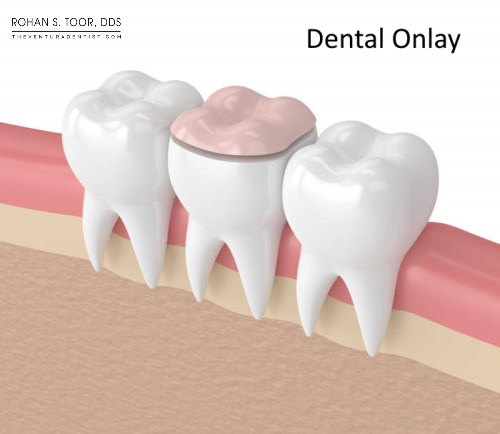 Dental onlays are a reliable and long-lasting way to fix cavities or other damage to teeth. These restorations have many benefits and are better than crowns and other dental restorations. Rohan Toor Dental Care and Dr. Rohan Toor have 5 years of experience with dental onlays.
Dental onlays are a reliable and long-lasting way to fix cavities or other damage to teeth. These restorations have many benefits and are better than crowns and other dental restorations. Rohan Toor Dental Care and Dr. Rohan Toor have 5 years of experience with dental onlays.
What is a Dental Onlay?
An onlay is used to protect the healthy part of a tooth. It only covers enough of the damaged part of the tooth to keep the restoration in place.
What are Dental Onlays Made Out Of?
- Gold - Gold offers the most long-lasting utilization. Gold is also very gentle on the surfaces of the opposing teeth, and less tooth structure needs to be taken away than with porcelain. The bad thing about it is that it doesn't match the color of natural teeth.
- Porcelain -The best cosmetic result is seen if the treated area is in the "smile zone." Porcelain is also tough to wear down, but it can wear down the teeth next to it if someone clenches or grinds their teeth.
- Composite resin - It matches the color of natural teeth and is as strong as gold and porcelain. However, it is more expensive.
- Ceramic - Made from stronger materials that last longer than fillings and crowns. Most of the time, they last longer and give damaged teeth more strength and support. But it costs more than some other materials.
When Should a Dental Onlay Be Used?
Dentists recommend an onlay when the structure of your tooth is weak, and they think a standard filling will cause it to break. An onlay is also best because it fixes broken or decayed areas while protecting healthy tooth structure. This ensures that the tooth will continue working for a long time.
How is a Dental Onlay Performed?
An onlay is made outside of the tooth by a lab worker. It fits over the cusps and into the tooth inside and outside. The dentist glues the onlay to the tooth with dental cement.
Make an Appointment with Dr. Rohan Toor at Rohan Toor Dental Care to see if you need Dental Onlay.
* FREE Porcelain Onlay Consultation ($100 Value)
* FREE Digital X-rays especially for Tooth Onlay ($150 Value)
* We Maximize your Insurance, so you pay less out of pocket
How much is Tooth Material Needed for a Dental Onlay?
The patient must have enough tooth structure to hold the onlay in place. Up to three-quarters of the natural tooth can be covered by an onlay.
How Long do Dental Onlays Last?
Journal of Esthetic and Restorative Dentistry says that most onlays last between 10 and 15 years. Onlays are not permanent, and like many other dental restorations, they may need to be changed at some point. How long a dental onlay lasts usually depends on where the damaged tooth is in the mouth, how strong the tooth next to it is, how healthy the nerves are inside the tooth, how well the patient takes care of their teeth, and how much stress and tension the onlay is put under.
How do I care for Porcelain Onlays?
After getting porcelain onlays, there is no special way to clean them. You should brush your teeth for 2 minutes at least twice daily and floss at least once daily. Use fluoride mouth to rinse once a day and eat less candy. Don't chew on ice or use your teeth to rip open food packages.
What are the Advantages of Dental Onlay?
Dental onlays protect the structure of teeth. Once they are bonded to your tooth, they make it stronger. You will keep more of your natural tooth, and your onlay can last up to 30 years.
How Much Does it Cost for a Dental Onlay?
The price of an onlay for each tooth is between $650 and $1,200. Onlays cost more than inlays because they take up more space in the mouth.
FAQs for Dental Onlay
Are Dental Onlays worth it?
Yes, onlays are worth the money. Onlays are still an excellent way to fix a tooth because they protect the natural tooth structure, don't get bigger, fit tightly, and make the teeth look natural.
Why does my tooth hurt after an Onlay?
After a dental onlay procedure, it is common for the tooth to be sensitive to pressure and temperature. After the last restoration has been put in, the sensitivity should go away in a few weeks. Take a pain reliever every four hours, such as Tylenol or ibuprofen, to eliminate any pain that doesn't go away (Motrin).
Areas We Serve: